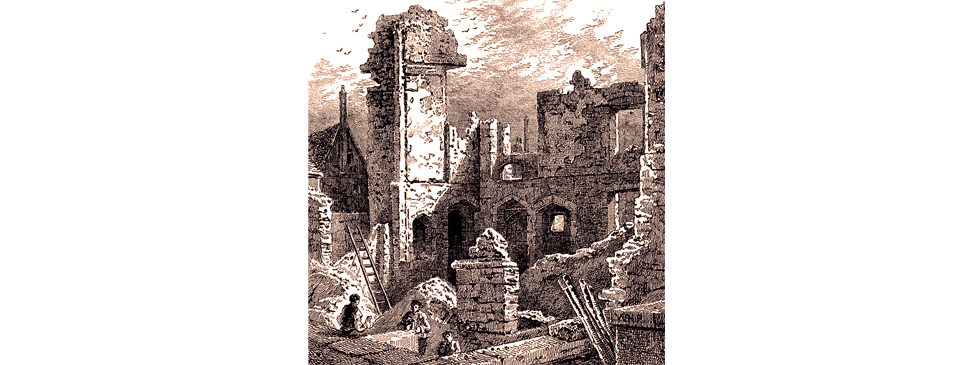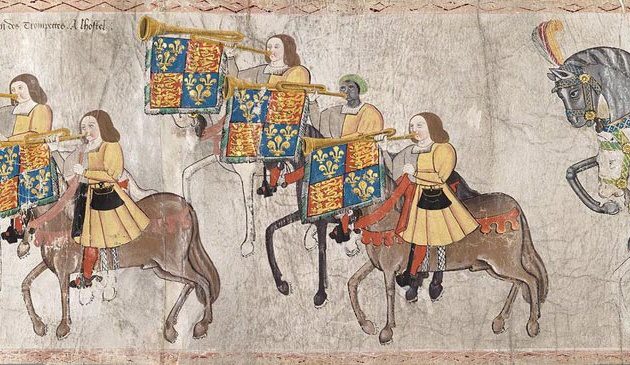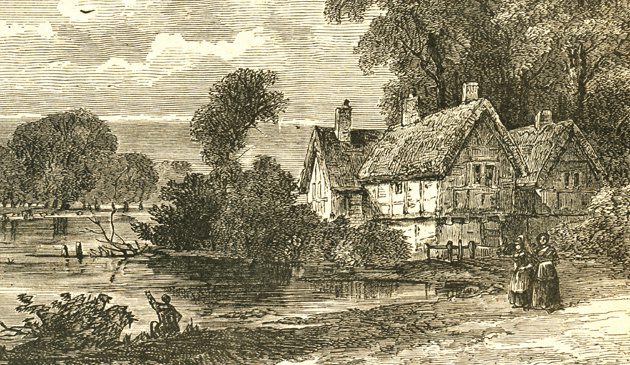Dissolution of the London monasteries

The ruins of the Convent of St. Clare’s at Aldgate, just outside the city wall, in a print published in 1797, more than 250 years after its dissolution. It had been founded in 1293 by the brother of King Edward I and his wife, the Queen of Navarre, and dedicated to St. Clare who had died fifty years earlier at Assisi. The nuns were known as Minoresses and their memory is perpetuated in the street name Minories, which today runs on the east side of the former convent. Part of its grounds later became a farm known as Goodman’s Fields.
Many properties simply remained empty for a time, falling into ruin and gradually finding new owners and uses over quite a long period. For example, much of Holy Trinity disintegrated until it was merely a shell. Over forty years later a survey recorded that the Romanesque arches remained but the roof was gone and within its shell a number of houses had been built. Others were simply demolished and built over, with the stonework used to create new buildings. Some properties had been rented out by the monasteries and probably continued with the same tenants but different landlords.
A number of the monastic churches were acquired by the local people as parish churches. Some monastic hospitals, such as those for lepers at St. Giles, St. Mary’s at Spitalfields, and St. James’s closed for ever. Henry had St. James’s Palace built on the site of the latter. Sir Richard Gresham, Lord Mayor of London, petitioned the King that St. Mary’s, St. Bartholomew’s at Smithfield, and St. Thomas’s in Southwark, should continue their charitable work under the control of the City. He proved persuasive in the case of the latter two, with St. Bartholomew’s re-founded by Henry and St. Thomas’s by the City, and they continue today as major secular hospitals. Richard’s brother, Sir John, later intervened on behalf of St. Mary of Bethlehem near Bishopsgate, which was by the 16th century primarily a secular hospital for the insane – ‘Bedlam’ – and was therefore never dissolved.
The monasteries were liberties, areas outside the control of the City of London, and that privilege continued in some instances into the 19th century even though the ecclesiastic estates were no longer in existence. Many of those areas, such as the former Carmelite (or Whitefriars) Priory south of Fleet Street, became havens for debtors, prostitutes, and refugees from the authorities. Several decades after its suppression Holywell was where James Burbage built his theatre at which Shakespeare’s plays were first performed. Norton Folgate, outside of Bishopsgate, later attracted religious dissenters such as Catholics and Quakers.
No doubt the price of land fell with so much of it coming on to the market so suddenly. During the 1560s a contemporary historian recorded that: “Fair houses in London are plenteous, and very easy to be had at low and small rents, and by reason of the late dissolution of religious houses many houses in London stood vacant…”.
Henry’s quarrel with the Pope impacted the entire country on a vast scale. Between 1536 and 1541 over 800 religious communities in England, Wales and Ireland were closed. In 1540 that averaged around 50 per month. Much of age and beauty, including buildings and sacred art and libraries, was destroyed or mutilated. Age-old traditions were discontinued. Twelve thousand monks, canons, friars and nuns were cast out onto the world, as well as many more lay people, the sick and the elderly. The large amount of property held by those institutions in and around London, consisting of buildings and farmland, was given over to Henry and his supporters in what was probably the largest transfer of land in London’s long history.
Sources include: John Schofield ‘London 1100-1600’; John Richardson ‘The Annals of London’; Liza Picard ‘Elizabeth’s London’; Sir Hubert Llewellyn Smith ‘The History of East London’; Dan Cruickshank ‘Spitalfields’; ‘Various – St. Paul’s – The Cathedral Church of London’; Christopher West ‘The Story of St. Katharine’s’. With thanks to Olwen Maynard for help with fact-checking, additional information, and proof-reading.
< Go back to Tudor London
< Go back to Religion and Churches


